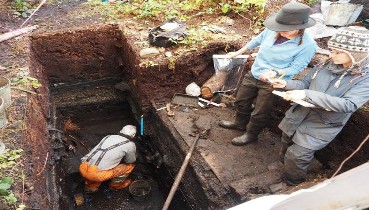
Andean People Already Perfected Skull Surgery Thousands of Years Ago
The Paracas skulls on display at the National Museum of Archaeology, Anthropology and History in Lima, Peru. Fisrt discovered Photo: Silentlight87
But back to trepanation (if elongation wasn’t enough). The ancient Peruvians left us evidence of the practice from 1000 years later, too (the skulls from that era were not elongated). Excavating burial caves in the south-central Andean province of Andahuaylas in Peru, U.C. Santa Barbara archaeologist Danielle Kurin and colleagues unearthed the remains of 32 individuals that date back to the Late Intermediate Period (ca. AD 1000-1250). Among them, 45 separate trepanation procedures were in evidence.
But hey (again), why would you want to remove a section of a person’s cranial vault anyway? According to Kurin, “when you get a knock on the head that causes your brain to swell dangerously, or you have some kind of neurological, spiritual or psychosomatic illness, drilling a hole in the head becomes a reasonable thing to do.”
Kurin reckons trepanations first appeared in the south-central Andean highlands during the Early Intermediate Period (ca. AD 200-600), although the technique was not universally practiced. Nevertheless, it was considered a viable medical procedure until the Spanish banned the practice in the early 16th century. That said, she wanted to know how trepanation came to exist in the first place. So she looked to a failed empire to get some answers.
But back to trepanation (if elongation wasn’t enough). The ancient Peruvians left us evidence of the practice from 1000 years later, too (the skulls from that era were not elongated). Excavating burial caves in the south-central Andean province of Andahuaylas in Peru, U.C. Santa Barbara archaeologist Danielle Kurin and colleagues unearthed the remains of 32 individuals that date back to the Late Intermediate Period (ca. AD 1000-1250). Among them, 45 separate trepanation procedures were in evidence.
But hey (again), why would you want to remove a section of a person’s cranial vault anyway? According to Kurin, “when you get a knock on the head that causes your brain to swell dangerously, or you have some kind of neurological, spiritual or psychosomatic illness, drilling a hole in the head becomes a reasonable thing to do.”
Kurin reckons trepanations first appeared in the south-central Andean highlands during the Early Intermediate Period (ca. AD 200-600), although the technique was not universally practiced. Nevertheless, it was considered a viable medical procedure until the Spanish banned the practice in the early 16th century. That said, she wanted to know how trepanation came to exist in the first place. So she looked to a failed empire to get some answers.
Advertisements
22 August 2023
Advertisements



